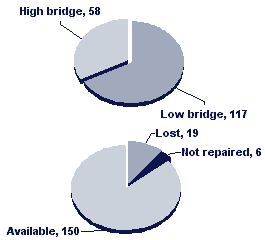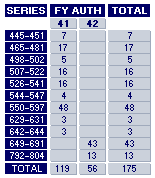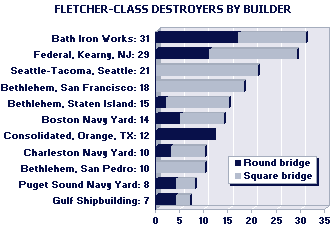

Introduced in 1942, the 2,100-ton Fletcher-class destroyers formed the core of the US Navy’s destroyer force from 1943.

Source: Friedman.
The Fletcher design permitted significant increases over preceding classes in hull, armament, machinery, ammunition, stores and fuel bunkerage.
At 2,050 tons standard displacement and approximately 2,900 tons fully loaded, the Fletchers were significantly larger than any preceding American destroyer classes. Authorized for fiscal year 1941, construction of the first ships was already under way when the United States entered the war. In an emergency program to expand capacity, some shipyards were upgraded and other new ones were brought on line. Eventually, eleven shipyards launched 175 ships over the next 32 months—the most numerous class of destroyer completed by any navy. They were also the first US destroyers fitted with radar as built.
CONSTRUCTION
Previous. The pace of US destroyer construction accelerated with the wartime Fletcher class. Laid down beginning in 1941, all 175 Fletchers were completed between June 1942 and February 1945, launched an average of 212 days after keel laying and commissioned after an average of 152 days more or 364 days total—nearly 10 per cent faster than the repeat Bensons and Gleaves that preceded them. Next.
The first 25 ships were ordered 28 June and 1 July 1940 (the first day of the 1941 fiscal year), with DD 445 actually belonging to the 1 July group. Christened USS Fletcher, she carried over several design features from the earlier classes, such as a rounded pilot house. Later emphasis on anti-aircraft defense led to a redesigned or “square” bridge for improved all-around sightlines, beginning with Brownson (DD 518). Thus there were two groups of 2,100-tonners: one-third (58) were “high-” or “round-bridge” ships; two-thirds, (117) were “low-” or “square-bridge” ships.

Construction (top) and disposition following World War II (bottom).
Meanwhile, the Navy continued looking ahead. In September 1941, it requested studies for a destroyer with greater anti-aircraft capability. In May 1942, before the first Fletcher was even commissioned, it approved a six-gun ship in which the Fletchers’ five 5-inch single mounts were replaced with three 5-inch twins—the 2,200-ton Allen M. Sumner class, with 20 per cent more firepower on a Fletcher hull widened by 14 inches. By VJ Day, 67 Sumners—55 destroyers and 12 destroyer-minelayer conversions—plus 45 ships of a lengthened production variant, initially referred to as the 2,200-ton “long hull” class and later as the Gearing class. Together, these classes dominated the US Navy’s destroyer force over the next 25 years.

Authorization by fiscal year.
As the first big ships to appear and because there were so many of them, however, the Fletchers are remembered as the signature US Navy destroyer class of the Pacific war. There, the earliest ones saw action in the nighttime surface battles in the Solomon Islands, many fought at Leyte and all completed in time for fleet screening and shore bombardment assignments and the notorious anti-kamikaze radar picket duty at Okinawa. While 19 were lost and six damaged beyond repair, 44 earned ten or more service stars, 19 were awarded the Navy Unit Commendation and 16 received the Presidential Unit Citation.
Some 2,100-tonners served off Korea in the 1950s and some even off Vietnam in the ’60s. Thirty-two were transferred to the navies of Argentina, Brazil, Chile, Columbia, Germany, Greece, Italy, Japan, Korea, Mexico, Peru, Spain, Taiwan and Turkey.

References: Bauer and Roberts, Friedman, Raven, Hearn.
One hundred seventy-five Fletcher-class destroyers from eleven builders were placed in commission between 4 June 1942 and 22 February 1945.By 1971, all ships remaining in the US Navy had decommissioned but not until 2001 was Mexico’s Cuitláhuac, the former John Rodgers and the last active Fletcher, retired. Despite talk of returning her to the United States as a museum ship, she was condemned in 2010 as a derelict and hazard to navigation and scrapped in 2010–2011.
Four Fletchers have been preserved on public display. In Greece, the former Charrette, renamed Velos (“Arrow”), is a popular attraction. In the United States, The Sullivans at Buffalo, Kidd (beautifully restored to late-World War II configuration) at Baton Rouge, and Cassin Young, berthed across the pier from the frigate USS Constitution at the Boston Navy Yard, Charlestown, Massachusetts, are open to the public.
1 LCdr. Fred Edwards, Destroyer Type Desk, Bureau of Ships, 1942, quoted in Holland, Rear Admiral W. J., Jr., USN (Ret), ed.; The Navy, page 115, 2000, Naval Historical Foundation, Washington.
2 Friedman, Norman, U.S. Destroyers, an illustrated design history, page 111, 1982, United States Naval Institute, Annapolis, MD.